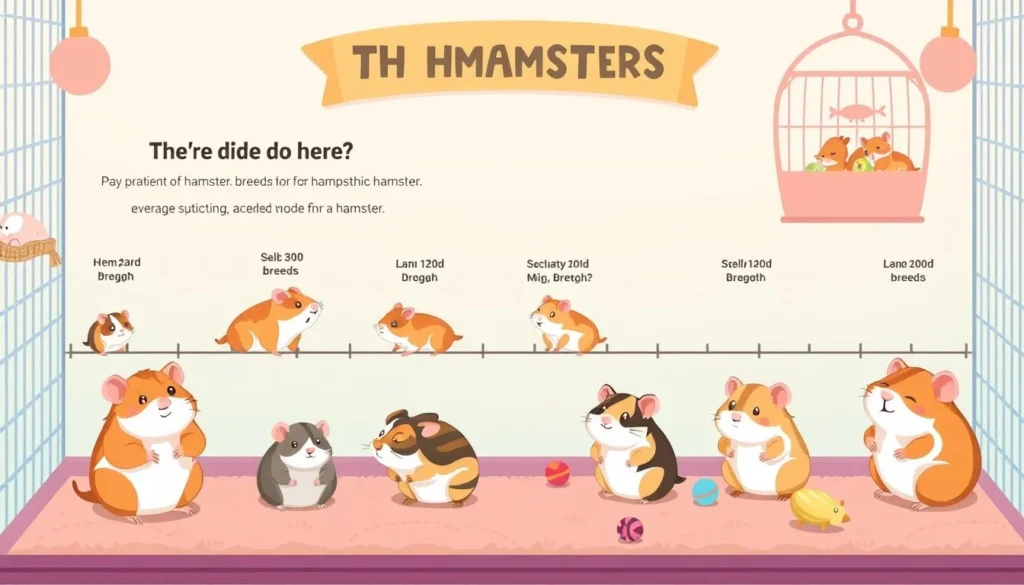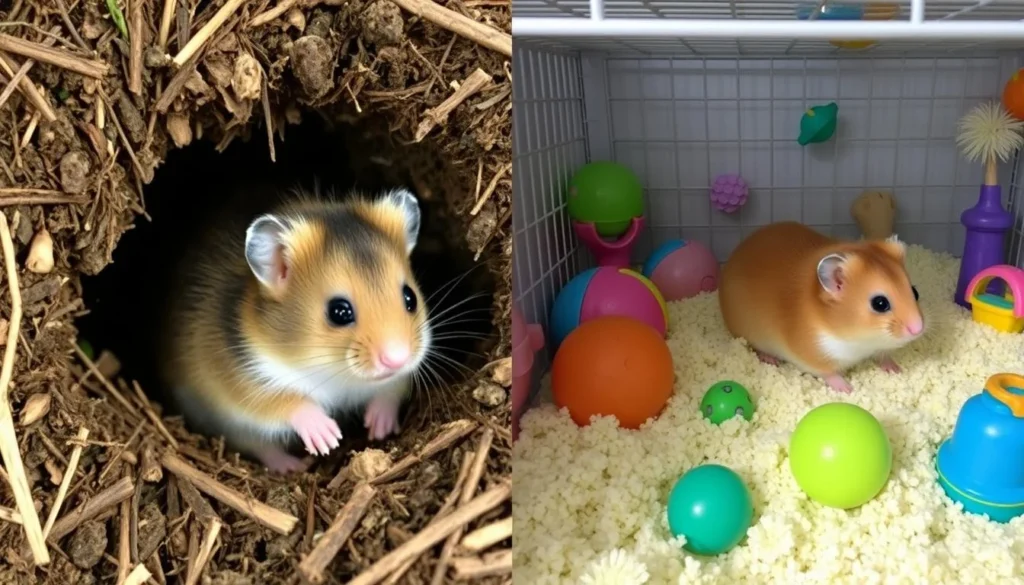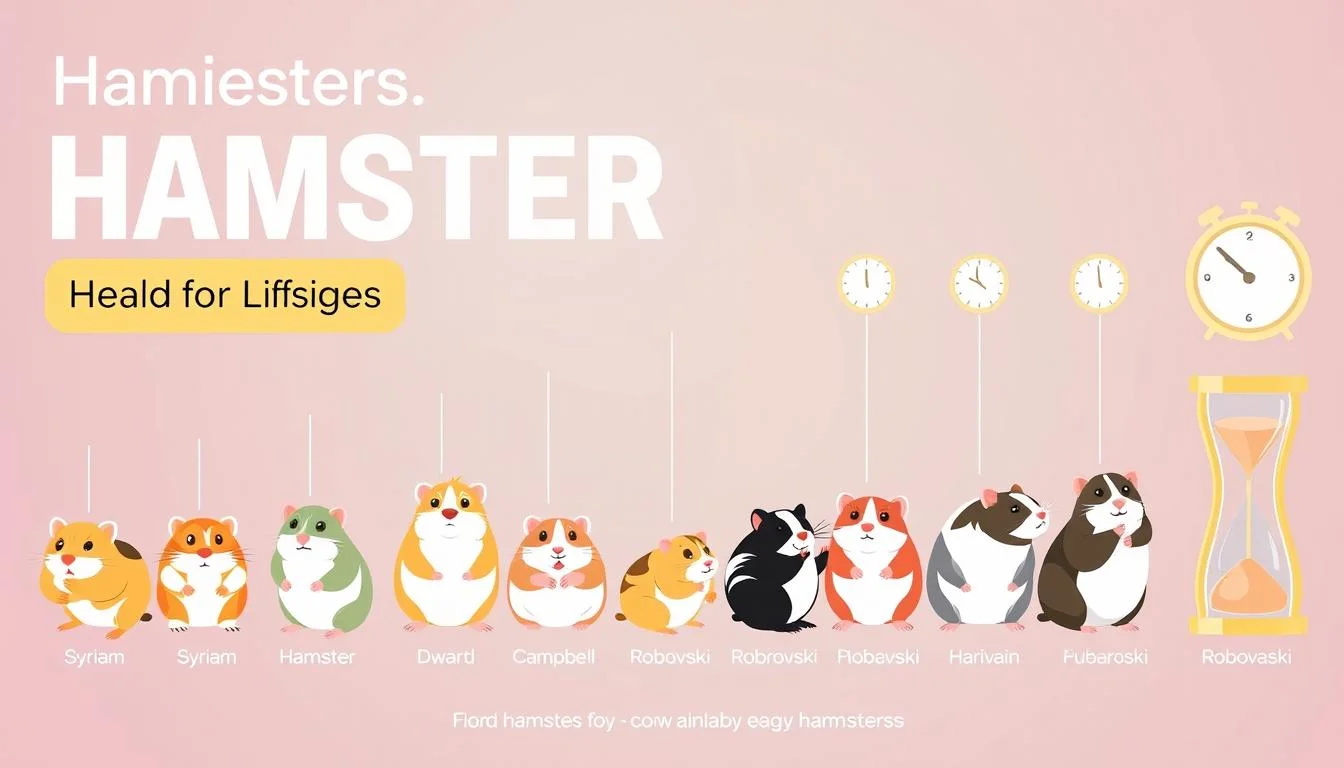Table of Contents
The first time I held a tiny hamster, I was captivated by its delicate charm and boundless energy. Those miniature bundles of fur have a way of stealing hearts. Understanding their lifespan is key for responsible pet ownership. Different hamster breeds can live surprisingly varied lives, typically ranging from 18 to 36 months in captivity.
Your furry friend’s journey is brief yet incredibly rich. While hamsters live relatively short lives compared to other pets, they pack an incredible amount of personality and joy into those years. Knowing about their lifespan helps you provide the best care and create meaningful memories with these adorable companions.
From Syrian to Dwarf hamster breeds, each type has unique characteristics that influence their longevity. Proper diet, habitat, and healthcare can significantly impact how long your hamster will thrive. This transforms those precious months into a lifetime of love and companionship.
Key Takeaways
- Average hamster lifespan ranges from 18 to 36 months
- Different hamster breeds have varying life expectancies
- Proper care can significantly extend a hamster’s life
- Hamsters are considered elderly around 1.5 years old
- Diet and habitat play a big role in hamster longevity
Understanding Pet Hamster Life Expectancy
Knowing how long your hamster will live is key to giving them the best care. Hamsters usually live for two to three years. This can change based on their breed, what they eat, and their health.

- Syrian hamsters: 2-3 years average lifespan
- Russian dwarf hamsters: 1.5-2 years
- Chinese hamsters: 1.5-2 years
- Roborovski hamsters: Up to 3.5 years
Factors Influencing Hamster Longevity
Several things can affect how long your hamster lives:
- Genetics
- Quality of diet
- Living environment
- Stress management
- Regular veterinary care
Age Milestones in Hamster Development
Knowing your hamster’s growth stages is important for their care. Hamsters grow fast, becoming adults in 4-6 weeks. They start to get older around 18 months.
Proper care and attention can help maximize your hamster’s lifespan and quality of life.
Wild vs Domestic Hamster Lifespans

Hamsters in the wild and those kept as pets show a big difference in how long they live. Wild hamsters face many dangers like predators and harsh weather. They also have to find food in a tough environment.
Wild hamsters are amazing at adapting to their surroundings. They live in complex underground tunnels. These tunnels offer little protection from dangers outside. On average, they live only 1 to 2 years. Domestic hamsters, on the other hand, can live up to 3 years.
- Wild hamster challenges:
- Constant predation risks
- Limited food availability
- Extreme environmental conditions
- Domestic hamster advantages:
- Consistent food supply
- Protected living environment
- Regular veterinary care
“Survival in the wild is a daily challenge for these tiny adventurers.”
Domestication has greatly increased hamster lifespan. Your pet hamster gets to live in a safe, controlled environment. They get regular food and care, which helps them live longer and healthier.
Knowing these differences helps us see how amazing hamsters are. It also shows how important it is to take good care of them to help them live longer.
Different Hamster Breeds and Their Lifespans
Exploring hamster breeds opens a world of tiny friends with special traits. Knowing about different hamster breeds helps you pick the right pet for you.
There are five main hamster breeds kept as pets. Each has its own unique qualities that attract different owners.
Syrian (Golden) Hamsters
Syrian hamsters, or golden hamsters, are the most loved pet hamsters. They live 2-3 years and grow to 6-8 inches long. They are known for:
- Larger size compared to dwarf varieties
- Weight around 4-5 ounces
- Domesticated in 1930
- Sociable and outgoing personality
Dwarf Hamster Varieties
Dwarf hamsters are great for those who want smaller pets. They come in different varieties with special traits:
- Russian Campbell Dwarf: About 4 inches long, lives 1.5-2.5 years
- Winter White Russian: Around 3.5 inches long, changes color with the seasons
- Can be housed in same-sex pairs or groups
Chinese and Roborovski Hamsters
Chinese and Roborovski hamsters add more variety for pet owners. Chinese hamsters are 3-5 inches long and live 2-3 years. Roborovski hamsters are the smallest, reaching just 2 inches.
“Each hamster breed offers a unique experience for pet enthusiasts!” – Hamster Experts
Roborovski hamsters are special because they live 3-5 years. They are a great choice for those who want a long-term pet.
How Hamsters Live: Creating the Ideal Habitat
Creating the perfect hamster habitat is key for your pet’s health and happiness. Your furry friend needs a big and exciting place to live. This place should be like their natural home. The right hamster habitats can greatly improve your pet’s life and health.
When setting up hamster supplies, consider these essential elements:
- Cage Size: Aim for at least 450 square inches of floor space
- Bedding Depth: Provide 6-8 inches of absorbent bedding
- Exercise Wheel: Choose a wheel at least 8 inches in diameter
- Temperature Range: Maintain 65°-75° Fahrenheit
Pro tip: A larger habitat allows more room for exploration and reduces stress for your hamster.
“A happy hamster is an active hamster” – Veterinary Hamster Care Guidelines
Your hamster’s habitat should have different areas for fun. Add hiding spots, chew toys, tunnels, and climbing structures. These keep your pet’s mind active. Change these items often to keep your pet interested and active.
Keeping the habitat clean is very important. Clean the cage every one to two weeks. Replace the bedding and clean the accessories to keep your pet healthy.
Essential Diet Requirements for Longevity
Keeping your hamster healthy is key to a long life. A balanced diet helps your hamster live longer than the usual two years.
It’s important to structure your hamster’s diet for their health. Knowing the right food balance is essential for their care.
Recommended Daily Food Portions
Here are some important diet guidelines for your hamster:
- 80% of the diet should consist of commercial hamster food
- 15% fresh fruits and vegetables
- 5% protein sources
Treats and Supplements
Treats can be fun for your hamster, but use them wisely. Limit treats to no more than 10% of the total diet to avoid obesity and nutritional problems.
Safe treat options include small pieces of boiled egg, lean chicken, or occasional insects.
Foods to Avoid
Some foods are harmful to your hamster and should be avoided:
- Whole oats (can damage cheek pouches)
- Sticky foods
- Excessive green vegetables (can cause diarrhea)
- Sugary or processed human foods
Always provide fresh water and watch your hamster’s weight and health. A careful diet plan can greatly improve your pet’s life and health.
Common Health Issues Affecting Lifespan
Knowing about hamster health is key to a long, happy life for your pet. Hamster care means spotting health problems early. The Royal Veterinary College found several common issues hamster owners should watch out for.
The most common health problems in hamsters are:
- Wet tail – A bacterial infection causing severe diarrhea
- Respiratory infections
- Dental problems with overgrown incisors
- Skin disorders
- Tumors and cancers
“Early detection is key to managing your hamster’s health and potentially extending their life,” veterinary experts recommend.
Some health concerns to keep an eye on include:
- Digestive disorders affecting 7.33% of hamsters
- Bite injuries from other hamsters (5.88% of cases)
- Overgrown nails (4.13%)
- Traumatic injuries (3.8%)
Good hamster health care means regular vet visits and watching your pet closely. Look for changes in appetite, activity, and any odd symptoms. These could mean a health problem.
By being proactive in hamster care, you can help your pet stay healthy. This can extend their life from 1.5 to 3 years.
Signs of Aging in Hamsters
As your hamster gets older, it’s key to know the signs of aging. Hamsters, like humans, go through big changes as they age.
Physical Transformations in Aging Hamsters
Aging hamsters show clear physical changes that need attention:
- Fur becomes thinner and less vibrant
- Reduced mobility and slower movements
- Weight loss or muscle mass reduction
- Dulling of eye clarity
- Potential dental wear
Behavioral Shifts in Senior Hamsters
Hamster behavior changes can signal aging. Look out for these signs:
- Decreased overall activity levels
- Longer sleep periods
- Reduced interest in playing or exploring
- Less frequent grooming
- Increased sensitivity to handling
Special Care for Elderly Hamsters
Your senior hamster needs special care for comfort and quality of life. Here are some tips:
- Provide softer bedding for joint comfort
- Adjust diet to support aging metabolism
- Create easily accessible habitat spaces
- Minimize handling to reduce stress
- Monitor health more frequently
“Aging is a natural process. With compassionate care, you can help your hamster enjoy its golden years peacefully.” – Veterinary Hamster Experts
While hamsters usually live 2-3 years, good care can make their senior years better.
Exercise and Mental Stimulation Impact
Keeping your hamster active and mentally sharp is key to their happiness and health. Hamster toys are essential for their physical and mental well-being. They greatly improve their life quality.
Hamsters love to move and solve problems. Here’s how to keep them active:
- Install an exercise wheel for daily cardiovascular activity
- Provide tunnels and mazes for exploration
- Use puzzle toys that encourage foraging instincts
- Rotate hamster toys to maintain interest
The right toys can make your hamster’s world exciting. Mental stimulation is just as important as physical exercise. Toys that challenge their minds can lower stress and prevent boredom.
“A stimulated hamster is a happy hamster” – Pet Wellness Experts
Exercise keeps hamsters healthy and strong. It helps them stay at a good weight and improves their heart and muscles. Interactive play and fun toys boost their behavior and energy.
Every hamster is different. Watch how they react to toys and change their play area to keep them happy and healthy.
Environmental Factors That Affect Hamster Health
Creating the perfect hamster habitats requires careful attention to environmental conditions. Your hamster’s health and comfort depend on maintaining an optimal living space. This space should support their well-being and longevity.
Understanding the critical environmental factors is key for effective hamster care. Hamsters are delicate creatures sensitive to their surrounding conditions.
Temperature and Humidity Control
Temperature is vital for your hamster’s health. The ideal temperature range for hamsters is between 75 to 85°F. Extreme temperatures can cause significant stress and health risks.
- Maintain consistent room temperature
- Avoid drafty areas near windows
- Use a thermometer to monitor room conditions
- Keep hamster habitats away from direct sunlight
Lighting and Sleep Cycles
Hamsters are nocturnal animals with specific sleep requirements. Disrupting their natural day-night cycle can lead to stress and health complications.
“A consistent light-dark cycle is essential for maintaining your hamster’s natural rhythm and overall well-being.”
- Provide 12-14 hours of darkness for sleeping
- Use soft, indirect lighting in their living area
- Avoid sudden light changes
- Create a quiet environment during daytime hours
By carefully managing these environmental factors, you can significantly improve your hamster’s quality of life. This can potentially extend their lifespan.
Veterinary Care and Regular Health Checks
Keeping your hamster healthy means regular vet visits and care. Your pet relies on you to watch over their health and spot problems early.
It’s important to find a vet who knows about small animals. Not all vets are familiar with hamsters. Look for exotic pet specialists who understand hamster health needs.
“Prevention is always better than cure, for small animals like hamsters.”
Here’s what regular health checks should include:
- Annual physical exams
- Weight checks
- Dental checks
- Skin and fur checks
Look out for signs that mean your hamster needs a vet right away, such as:
- Changes in eating
- Unusual discharges
- Feeling tired or less active
- Hard breathing
Even though hamsters don’t need yearly shots, yearly vet visits are important. Your eyes are key in keeping your hamster healthy between vet visits.
Hamsters grow old fast, so early care is vital. It helps them live longer and happier lives.
Record-Breaking Hamster Lifespans
Many pet owners are amazed by how long some hamsters live. The Guinness World Record for the oldest hamster shows the power of great care and genetics.
“Some hamsters defy typical lifespan expectations through remarkable care and genetic luck.”
The record holder, a hamster from the UK, lived 4 years and 42 days. This shows how important care and luck can be. It helps us know how to take better care of our hamsters.
- Most hamsters live 2-3 years
- Syrian hamsters can live up to 4 years with great care
- Roborovski hamsters usually live 3-3.5 years
- Genetics are key in how long a hamster lives
Hamster breeds vary in how long they live. Syrian hamsters often live longer than dwarf types. With the right food, less stress, and vet visits, your hamster might live longer than usual.
Things that help hamsters live longer include:
• A balanced diet
• A calm place to live
• The right size of home
• Regular vet visits
• Good genes
While it’s rare for hamsters to live a long time, it motivates us to care for them even more.
Conclusion
Knowing how to care for your hamster is key to their happiness and health. Hamsters can live for 2 to 3 years. Their life quality depends on how well you take care of them.
Every hamster breed, like Syrian or Dwarf, needs special care. This includes the right food, a clean home, and enough exercise. You also need to understand their individual needs.
To help your hamster live well, you must create a great care plan. This means a big, clean cage, the right food, lots of playtime, and less stress. Even though genetics matter, your efforts can greatly improve their health and life span.
It’s important to take your hamster to the vet regularly. Also, keep them mentally active and know their behavior. By following this guide, you can make a happy home for your hamster. This can even make their life longer and strengthen your bond.
Every hamster is different. By learning, adjusting, and caring for them, you can help them thrive. Enjoy the time you spend with your hamster, filled with patience, love, and knowledge.
